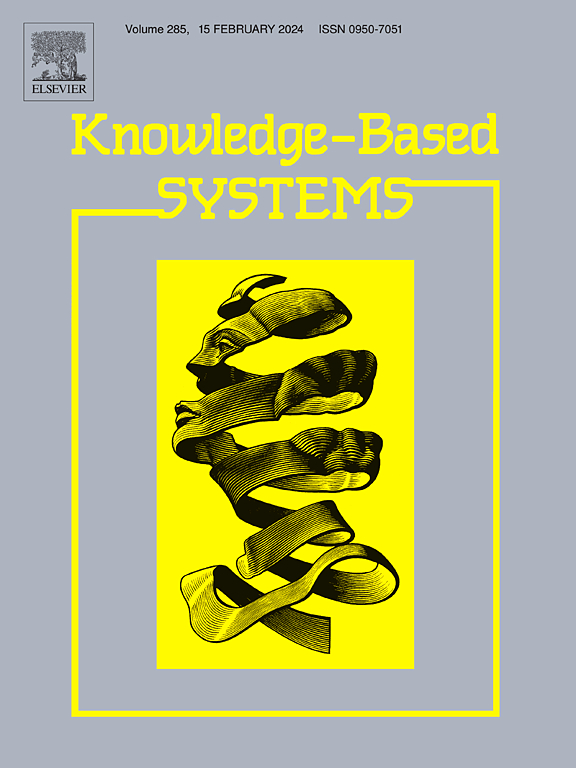CSDD-Net: A cross semi-supervised dual-feature distillation network for industrial defect detection
IF 7.2
1区 计算机科学
Q1 COMPUTER SCIENCE, ARTIFICIAL INTELLIGENCE
引用次数: 0
Abstract
Detecting defects in industrial products is crucial to the strict quality control of products. Most current methods focus on supervised learning, relying on large-scale labeled samples. However, the forms of defects in industrial scenarios vary, and the data collection cost is high, which makes it difficult to meet the high requirements of massive labeled data. Therefore, we propose a Cross Semi-Supervised Dual-Feature Distillation Network (CSDD-Net), which aims to cross-use supervised and semi-supervised networks to learn rich feature representations and the distribution of large-scale features, respectively. CSDD-Net can transfer the defect feature distribution learned on partially labeled data in supervised branch to unsupervised branch, achieving simultaneous modeling and distillation based on partially labeled data. Firstly, this paper proposes a cross-local-global feature extraction network. By designing double interaction and ghost linear attention structure, it aims to force the network to be able to focus on local detail texture in global features and local features to perceive global semantics. Secondly, this paper proposes a Closed-Loop Cross-Aggregation Network (CLCA-Net), which considers deep and shallow semantics and fine-grained information. Thirdly, this paper designs a dynamic adaptive distillation loss, which could automatically adjust a more suitable regression loss function according to the defect characteristics, ensuring that the model could accurately locate and regress defects of various scales. Finally, this paper proposes a Glass Bottleneck defect dataset and verifies the feasibility of CSDD-Net in practical industrial applications. CSDD-Net achieved [email protected] of 80.41%, 76.42%, and 97.12% on the Glass Bottleneck, Wood, and Aluminum datasets with only 13.5 GFLOPs.
CSDD-Net:用于工业缺陷检测的交叉半监督双特征蒸馏网络
检测工业产品中的缺陷对于严格控制产品质量至关重要。目前大多数方法都侧重于监督学习,依赖于大规模标记样本。然而,工业场景中的缺陷形式多样,数据收集成本高,难以满足海量标注数据的高要求。因此,我们提出了交叉半监督双特征蒸馏网络(Cross Semi-Supervised Dual-Feature Distillation Network,CSDD-Net),旨在交叉使用监督网络和半监督网络,分别学习丰富的特征表征和大规模特征的分布。CSDD-Net 可以将在有监督分支中部分标注数据上学习到的缺陷特征分布转移到无监督分支中,实现基于部分标注数据的同步建模和提炼。首先,本文提出了一种跨局部-全局特征提取网络。通过设计双重交互和幽灵线性注意结构,迫使网络能够关注全局特征中的局部细节纹理,并通过局部特征感知全局语义。其次,本文提出了一种闭环交叉聚合网络(CLCA-Net),它考虑了深浅语义和细粒度信息。第三,本文设计了动态自适应蒸馏损失,可根据缺陷特征自动调整更合适的回归损失函数,确保模型能准确定位和回归各种规模的缺陷。最后,本文提出了一个玻璃瓶颈缺陷数据集,并验证了 CSDD-Net 在实际工业应用中的可行性。在玻璃瓶颈、木材和铝数据集上,CSDD-Net 仅用 13.5 GFLOPs 就实现了 80.41%、76.42% 和 97.12% 的 [email protected]。
本文章由计算机程序翻译,如有差异,请以英文原文为准。
求助全文
约1分钟内获得全文
求助全文
来源期刊

Knowledge-Based Systems
工程技术-计算机:人工智能
CiteScore
14.80
自引率
12.50%
发文量
1245
审稿时长
7.8 months
期刊介绍:
Knowledge-Based Systems, an international and interdisciplinary journal in artificial intelligence, publishes original, innovative, and creative research results in the field. It focuses on knowledge-based and other artificial intelligence techniques-based systems. The journal aims to support human prediction and decision-making through data science and computation techniques, provide a balanced coverage of theory and practical study, and encourage the development and implementation of knowledge-based intelligence models, methods, systems, and software tools. Applications in business, government, education, engineering, and healthcare are emphasized.
 求助内容:
求助内容: 应助结果提醒方式:
应助结果提醒方式:


